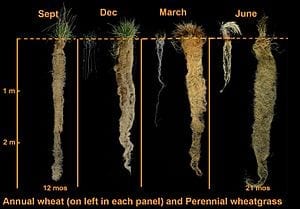Annual grains feed the world, but they create problems. Perennials are thrifty. Their long roots hold on to soil, water, and fertilizer, which means less pollution.
Humans made an unwitting but fateful choice 10,000 years ago as we started cultivating wild plants: We chose annuals. All the grains that feed billions of people today—wheat, rice, corn, and so on—come from annual plants, which sprout from seeds, produce new seeds, and die every year. “The whole world is mostly perennials,” says USDA geneticist Edward Buckler, who studies corn at Cornell University. “So why did we domesticate annuals?” Not because annuals were better, he says, but because Neolithic farmers rapidly made them better—enlarging their seeds, for instance, by replanting the ones from thriving plants, year after year. Perennials didn’t benefit from that kind of selective breeding, because they don’t need to be replanted. Their natural advantage became a handicap. They became the road not taken.
Today an enthusiastic band of scientists has gone back to that fork in the road: They’re trying to breed perennial wheat, rice, and other grains. Wes Jackson, co-founder and president of the Land Institute in Salina, Kansas, has promoted the idea for decades. It has never had much money behind it. But plant breeders in Salina and elsewhere are now crossing modern grains with wild perennial relatives; they’re also trying to domesticate the wild plants directly. Either way the goal is crops that would tap the main advantage of perennials—the deep, dense root systems that fuel the plants’ rebirth each spring and that make them so resilient and resource efficient—without sacrificing too much of the grain yield that millennia of selection have bred into annuals.
We pay a steep price for our reliance on high yields and shallow roots, says soil scientist—and National Geographic emerging explorer—Jerry Glover of the Land Institute. Because annual root crops mostly tap into only the top foot or so of soil, that layer gets depleted, forcing farmers to rely on large amounts of fertilizers to maintain high yields. Often less than half the fertilizer in the Midwest gets taken up by crops; much of it washes into the Gulf of Mexico, where it fertilizes algae blooms that cause a vast dead zone around the mouth of the Mississippi. Annuals also promote heavy use of pesticides or tillage because they leave the ground bare much of the year. That allows weeds to invade.
Above all, leaving the ground bare after harvest and plowing it in planting season erodes the soil. No-till farming and other conservation practices have reduced the rate of soil loss in the U.S. by more than 40 percent since the 1980s, but it’s still around 1.7 billion tons a year. Worldwide, one estimate put the rate of soil erosion from plowed fields at ten to a hundred times the rate of soil production. “Unless this disease is checked, the human race will wilt like any other crop,” Jackson wrote 30 years ago. As growing populations force farmers in poor countries onto steeper, erodible slopes, the “disease” threatens to get worse.










